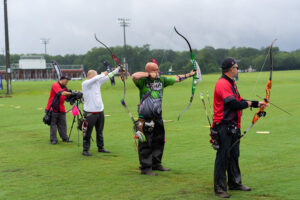In a few short months, the best archers in the world will gather in Tokyo to compete for Olympic glory. The tournament begins with a ranking round where archers shoot 72 arrows at targets 70 meters away. They are then ranked by their cumulative score and placed in a bracket. Archers shoot head-to-head matches, making their way through the bracket to determine who goes home with gold, silver and bronze.
While watching these exciting matches, you’ll see only one style of bow: the Olympic recurve. These bows use accessories that differ from those on other recurve bows.
They have three primary components: the riser and two limbs. The bow quickly disassembles for travel or to switch to heavier or lighter draw-weight limbs. The riser includes the bow’s grip, and it also has mounts for sights and an arrow rest.
The limbs generate the bow’s power when bending in unison as the bowstring is drawn. When the bowstring is released, the limbs snap forward, releasing stored energy to propel the arrow to the target.
If you look at an Olympic archer’s bow, you’ll also see long rods jutting out from the riser. These are stabilizers, and they help steady the bow for precise aiming. The bows also include a clicker, sight and arrow rest. A clicker is a “draw check” that clicks when the arrow is pulled to full draw. The audible click lets archers know they’ve reached full draw, and it’s OK to shoot, which ensures a consistent draw and release. The sight on an Olympic bow has fine adjustments, which increase aiming precision. The rest holds and guides the arrow as it leaves the bow.
While the Olympic recurve is the type of bow Olympians shoot, it’s also the bow of choice for thousands of recreational archers who enjoy this discipline. In addition to the Olympics and just plain fun, these bows are used in 3D, target, indoor and field archery.
How do you get started?
The first step is to locate an archery shop that offers lessons, and to sign up for a private introductory lesson. Many archery shops offer rental equipment so you can try the sport without investing in gear. After you get hooked on archery during your first lesson, sign up for more or for an archery program such as Junior Olympic Archery Development.
Eventually, you’ll want to buy your own bow. The staff at an archery shop will help you make the right gear decisions, but the most important thing to keep in mind is that a bow must fit you. It needs to be of the right length and draw weight to match your current strength and draw length. A bow that fits you will be easier and more enjoyable to shoot. With a bow, arrows and archery lessons, you have a great start in a rewarding sport that can be enjoyed for a lifetime.
Get started in your new hobby by locating an archery shop near you with the Archery 360 store locator.
Now that you know more about Olympic recurves, you can continue your education with the following in-depth articles.
Fundamentals of a Recurve Anchor Point
Basics for Setting Up an Olympic Recurve



